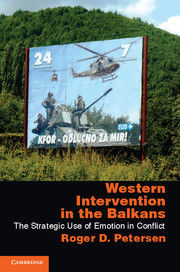Book contents
- Frontmatter
- Contents
- Acknowledgments
- Part 1 Background and Theory
- 1 Western Intervention in the Balkans
- 2 Emotions as Resources
- 3 The Strategic Use of Emotions, I
- 4 Intervention Games
- 5 The Strategic Use of Emotions, II
- 6 The Strategic Use of Emotions, III
- Part 2 Cases and Tests
- Appendix A A Note on Names
- Appendix B Alternative Arguments
- References
- Index
- References
5 - The Strategic Use of Emotions, II
Developing Strategies; Examples from Non-Balkan Cases
from Part 1 - Background and Theory
Published online by Cambridge University Press: 05 June 2012
- Frontmatter
- Contents
- Acknowledgments
- Part 1 Background and Theory
- 1 Western Intervention in the Balkans
- 2 Emotions as Resources
- 3 The Strategic Use of Emotions, I
- 4 Intervention Games
- 5 The Strategic Use of Emotions, II
- 6 The Strategic Use of Emotions, III
- Part 2 Cases and Tests
- Appendix A A Note on Names
- Appendix B Alternative Arguments
- References
- Index
- References
Summary
Introduction
The previous chapter addressed the structure of the “games” set up by Western interveners. Although these games take different forms, they rest on some common assumptions about actors, preferences, and strategies. First, there should be a stable set of recognized players. Second, these players should put interests, in the form of material and political gains, before revenge or forms of identity politics. Third, the contestants in this game should choose only among a limited range of strategies determined by the intervener.
Opponents of intervention games believe that they can strategically use emotions to alter each of these three fundamental game elements. This chapter will address how opponents use emotions as resources to alter (1) preferences, (2) actors, and (3) strategies. In a fourth section, the chapter will discuss how the distribution of emotions can also serve as a constraint on action as well as a resource.
- Type
- Chapter
- Information
- Western Intervention in the BalkansThe Strategic Use of Emotion in Conflict, pp. 80 - 96Publisher: Cambridge University PressPrint publication year: 2011

